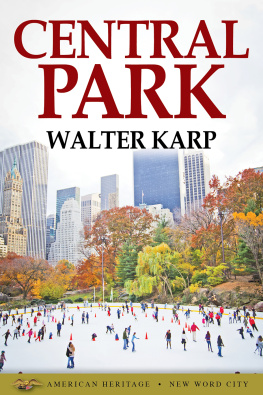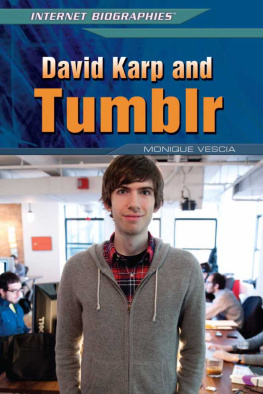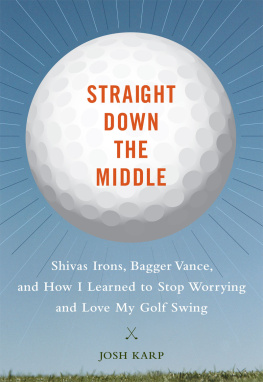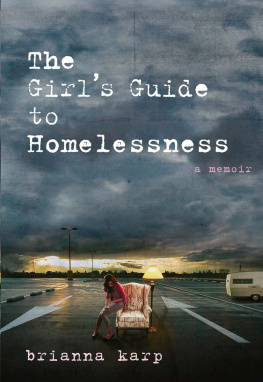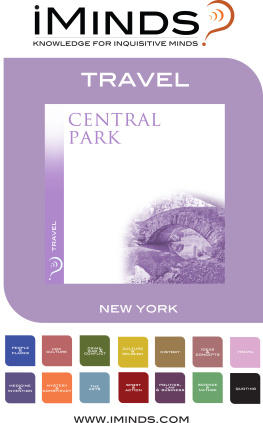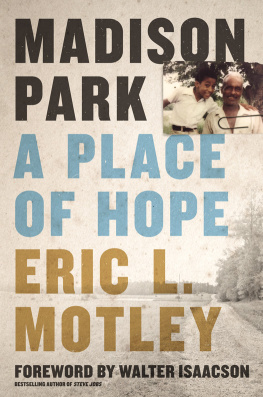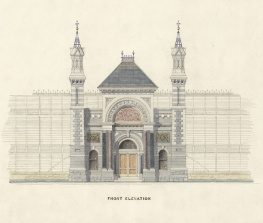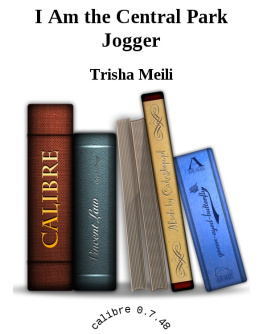Walter Karp - Central Park
Here you can read online Walter Karp - Central Park full text of the book (entire story) in english for free. Download pdf and epub, get meaning, cover and reviews about this ebook. year: 2014, publisher: New Word City, Inc., genre: Science. Description of the work, (preface) as well as reviews are available. Best literature library LitArk.com created for fans of good reading and offers a wide selection of genres:
Romance novel
Science fiction
Adventure
Detective
Science
History
Home and family
Prose
Art
Politics
Computer
Non-fiction
Religion
Business
Children
Humor
Choose a favorite category and find really read worthwhile books. Enjoy immersion in the world of imagination, feel the emotions of the characters or learn something new for yourself, make an fascinating discovery.
- Book:Central Park
- Author:
- Publisher:New Word City, Inc.
- Genre:
- Year:2014
- Rating:4 / 5
- Favourites:Add to favourites
- Your mark:
- 80
- 1
- 2
- 3
- 4
- 5
Central Park: summary, description and annotation
We offer to read an annotation, description, summary or preface (depends on what the author of the book "Central Park" wrote himself). If you haven't found the necessary information about the book — write in the comments, we will try to find it.
New Yorks Central Park has captured the hearts of nature lovers the world over. Yet its meadows, brooks, and glens are man-madeand the man who made them was Frederick Law Olmstead. Here, in this short-form book by award-winning historian and journalist Walter Karp, is its surprising and seldom-told story.
Central Park — read online for free the complete book (whole text) full work
Below is the text of the book, divided by pages. System saving the place of the last page read, allows you to conveniently read the book "Central Park" online for free, without having to search again every time where you left off. Put a bookmark, and you can go to the page where you finished reading at any time.
Font size:
Interval:
Bookmark:
In the center of the island of Manhattan sits a long rectangle of parkland known appropriately as Central Park. On Saturday and Sunday mornings, when cars are banned, it seems wonderfully at odds with the surrounding city, pitting undulating meadows against New Yorks sharp angles, trees and flowers against brick and asphalt, and winding paths against the unbending streets of Manhattans remorseless grid. On such mornings, Central Park resembles a small, defenseless principality a sort of municipal Liechtenstein - surrounded by a predatory empire, hostile to its spirit, and covetous of its lush fields. Yet miraculously, it endures.
The Central Park, as it used to be called, has survived for almost 160 years, and no one knows why. It marks the unexpected triumph of natures poetry over practicality and of a certain vague - yet pervasive - sentiment over the hard calculations of interest and profit. As Henry James noted in 1907, Central Park has a remarkable little history, although it is known to few New Yorkers. In fact, most are unaware that the park has any history . According to the prevailing New York view, the city fathers set aside a lovely swatch of primeval meadow and forest, laid in some paths and roads, then more or less washed their hands of it. In truth, Central Park is not a piece of prehistoric Manhattan. It is man-made throughout: every copse, glade, pond, and meadow. The city fathers had little to do with its making and would have strangled it at birth had they dared. They were being true to the traditions of the city - a city which had decreed by law that artistry and sentiment would have to get along on their own and not be a charge on the taxpayers.
The law in question was enacted in 1811, when city fathers decided that the future development of Manhattan would proceed along straight lines and right angles and the future metropolis would become an unbroken succession of rectangular blocks. Forthright and confident about the merits of their grid plan, they reportedly dispensed with circles, ovals and stars for the plain and simple reason that right angled houses are the most cheap to build. They left few vacant spaces for posterity because New Yorks posterity would never need them; those large arms of the sea that embrace Manhattan rendered public spaces wholly unnecessary to the health of the citizenry. It was noted that sea breezes were uncommonly cheap, while the price of land in Manhattan was uncommonly great. The 1811 grid plan did, however, allow for a large parade ground for New Yorks militia, but as soon as the expanding city got within a mile of it, New York sold it off to real-estate speculators. That city fathers ever provided any public space for the citizens of Manhattan is the first and fundamental miracle in the history of Central Park.
It was William Cullen Bryant , a poet-turned-newspaper editor, who first took note of the squalid fate in store for a city relentlessly marching northward - uptown in New York parlance - without a single park to compare with the royal parks of London. His article appeared in 1844, a year before the Great Famine in Ireland and four years before revolutions in Germany brought to New York the unprecedented influx of foreigners that ultimately led to the construction of Ellis Island . The population in 1844 was an ample 370,000, and the city was already characteristically cramped, noisy, and incorrigibly filthy. In the richest town in America, the chief instruments of garbage disposal were scavengers, both human and porcine. A Scottish visitor wrote about the side streets: The scene of confused debris was of a kind not to be easily forgotten... Ashes, vegetable refuse, old hats without crowns, worn-out shoes, and other household wreck lay scattered about as a field of agreeable inquiry for a number of long-legged and industrious pigs.
The pace of New York was so hectic it left foreign visitors nerve-wracked. Nothing and nobody seem to stand still for half a moment in New York, complained Lady Emmeline Stuart-Wortley in 1849, when the population had topped 500,000. The huge omnibuses, she reported, drive like insane vehicles from morning til night [and] appear not to pause to take up their passengers. Private oases were few but conspicuous. By 1844, 5th Avenue had become the new center of wealth and fashion as far uptown as 14th Street. Beyond it lay a lightly populated anymans land, speckled with pigtowns of tin-roofed shanties, a few doomed farmsteads, and little rows of town houses waiting for the town to catch up. The undeveloped parts of Manhattan were so disagreeable that few wealthy New Yorkers kept pleasure carriages because driving out of town was no pleasure at all. This fact had considerable bearing on the future Central Park.
For that future park, poet-turned-editor Bryant timed his historic first blow for the July 3, 1844, issue of the Evening Post . He pleaded for the immediate creation of an extensive pleasure ground for shade and recreation. The date was no accident. Bryant hoped to catch the sachems of the Tammany Society in a moment of civic weakness. It was on July 4 that the sachems - a semi-secret oligarchy that ruled New York in the name of the Democratic Party - made their annual public appearance and pledged their undying devotion to the precepts of Thomas Jefferson and the well-being of common men and women. But Bryants plea for the common people fell on deaf Tammany ears, which was not surprising - even to Bryant. Doing as little as possible for the commonality was the abiding principle of Tammany politics. Give the citizens an unnecessary inch - clean streets, for example - and they were liable to demand a yard. To the sachems, an extensive pleasure ground for the people was not a good idea; it was subversive.
Nonetheless, Bryant kept hammering away, and by 1850, he had gained the ardent support of a crusading young landscape architect named Andrew Jackson Downing . Downings journal, The Horticulturalist , enjoyed favor among liberal spirits in New Yorks upper ten thousand. (The days when the citys high society would restrict itself to the Four Hundred still lay four decades in the future.) Downings eloquent voice helped considerably.
In 1850 an annus mirabilis in the parks history - Tammany blundered. Normally, the sachems wanted as mayors respectable idlers, but that year they nominated a Quaker businessman named Fernando Wood , unaware that Wood harbored ambitions of the most dangerous sort. A genuine political desperado, he hoped to become the boss of all the little Tammany bosses - in essence, a second Aaron Burr . After that, the presidency itself seemed not beyond reach. Wood took step one to fulfill this secret ambition during his mayoralty campaign: He came out strongly for a great public park on the lines laid down by Bryant and Downing. Subsequently, the park idea became a major public issue and a warm public hope - so warm, in fact, that Woods successful rival, Whig candidate Ambrose Kingsland , endorsed it with equal vigor and promoted its cause when he became mayor.
Commercial interests howled in rage. A Peoples Park, as Downing called it, would become a den of thieves and ruffians; it would slice a chunk off the tax rolls and waste the taxpayers money. Downing wrote about providing a real feeling of the breadth and beauty of green fields, but what the mighty Journal of Commerce saw in green fields was a perpetual edict of desolation visited upon acres and acres of building lots. Such a park, Downing said, is republican in its very idea and tendency, but the parks influential enemies denounced it as a species of monarchical extravagance. The more they raged, however, the more popular the park idea became. Thanks to two crusading artists, an ambitious politician, and citizens who knew a good thing when they heard one, city fathers lost control of events. In 1853, the state legislature authorized the city to purchase a central reservation of land - half a mile wide and nearly two and a half miles long - that carefully respected the still-nonexistent streets of New Yorks inviolable grid. It was bounded on the south by the future 59th Street, on the north by 106th Street (extended a few years later to its present 110th Street boundary), on the west by 8th Avenue, and on the east by 5th Avenue. It initially comprised some 760 acres, 143 of which came free of charge since the site included two city reservoirs - a bargain regarded as one of the chief merits of the central location.
Next pageFont size:
Interval:
Bookmark:
Similar books «Central Park»
Look at similar books to Central Park. We have selected literature similar in name and meaning in the hope of providing readers with more options to find new, interesting, not yet read works.
Discussion, reviews of the book Central Park and just readers' own opinions. Leave your comments, write what you think about the work, its meaning or the main characters. Specify what exactly you liked and what you didn't like, and why you think so.

